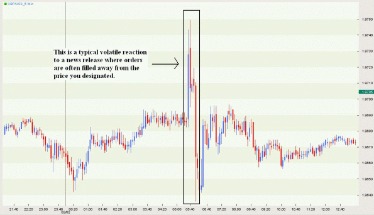
The pennant is created when the highs and lows of this consolidation form a symmetrical triangle. A breakout from this triangle to the downside signals that the downtrend will continue, and prices will likely fall further. The latter offers a great risk-reward since the entry is at a higher price and the stop loss is very close to the entry, hence, you are risking very few pips. The former makes sure that you don’t miss out on a trade, as there are no guarantees that a throwback may take place at all, which is exactly what happens in this case. Hence, the breakout was really strong, without offering us the second option.
- A position is opened after the price breaks out the upper edge of the pattern.
- Trend continuation patterns usually comprise several candles because it takes time to get confirmation.
- After intensive price growth, the price began to consolidate within the borders of the pennant.
- Bearish pennants and bullish pennants can indicate that major price action is on the cards – so understanding them is crucial for any technical trader.
- The amount you get can be used as a profit target after the breakout.
This is the initial move in the market that signals that prices are likely to fall. The downtrend should be well-established before the pennant forms. Also, the downtrend should be relatively steep, increasing the chances of a successful breakout from the pennant.
How do you target stop losses in bearish pennant patterns?
After a short accumulation period, the price broke through the lower boundary of the pennant with an impulse candlestick, which eventually reached the support level. Technically, the pattern begins forming after an impulse grows to a certain level. After that, the market calms down, and trading volumes decline. It’s usually not that easy to recognize the end of a correction. Any component of a correction may be far from the last one, even if everything points to it [for example, irregular corrections in wave theory]. Pennants are price action patterns represented in the form of a chart — it can be either a daily, weekly, or monthly chart.
- The typical bearish pennant identified has a weak trend after the pattern confirms, meaning the price has a high probability of retracing against the trade.
- – A bear flag pattern is a reliable indicator for predicting the continuation of a bearish trend.
- And here’s another example from the crypto sphere — formed on the BTC/USD candle chart.
The triangular flag pattern is a relatively reliable predictor of future price movements, but there are a few things you need to keep in mind. The breakout often comes with strong selling pressure (volume) after the bears dominate the market sentiment. A breakout to the downside occurs when prices break below the lower trendline of the flag formation. This information has been prepared by IG, a trading name of IG US LLC. This material does not contain a record of our trading prices, or an offer of, or solicitation for, a transaction in any financial instrument. You should not treat any opinion expressed in this material as a specific inducement to make any investment or follow any strategy, but only as an expression of opinion.
What is the difference between a bearish pennant and a bullish pennant?
There are two main types of chart patterns – reversal patterns and continuation patterns . The bear pennant is a continuation pattern that signals that the ongoing trend is likely to continue. It occurs during a bearish trend and indicates a possible extension of a downtrend. Forex traders use this classical chart pattern to join the existing trend and short sell an asset.
Bear and Bull Flag Patterns Explained – LCX
Bear and Bull Flag Patterns Explained.
Posted: Fri, 14 Apr 2023 07:00:00 GMT [source]
One of the most important things to remember when trading this pattern is to wait for the breakout. Don’t try to anticipate the move, as this can lead to false breakouts. Instead, wait for prices to break out of the triangle before executing a trade. This pattern should only be traded in the context of a downtrend. If stock prices are in an uptrend or sideways trend, this pattern is less likely to be successful.
Limitations of the Bear Pennant Pattern
Let’s take a closer look at trading the bullish pennant pattern according to this strategy using Tesla stock as an example. With a more aggressive trading strategy, a trade can be entered within the pennant pattern formation since the trend lines are predetermined. With a bullish pennant, you need to wait until the price drops to the lower border of the pattern and enter a bullish long trade. The principle of determining the bearish pennant pattern in the price chart is the same as with the bullish pennant, only in the opposite direction. As in a bearish flag, sellers push the price down, after which there is a short-term consolidation phase of the asset and a continuation of the downtrend. There are a few different ways to trade this pattern, but before we get into that, it’s essential to understand the psychology behind it.

With each wave, the lows are anchored higher, and the price range becomes narrower. Usually, to enter long, traders take into account the fact of breaking the resistance line or rolling back to it. Trend continuation patterns usually comprise several candles because it takes time to get confirmation. Traders can’t claim that the trend has resumed by one or two candles.
How to Identify a Bear Flag Pattern?
As the price declined, bulls started to come in, which led to a small triangle pattern. One of the primary advantages of using AI-driven technical analysis tools such as TrendSpider is the capability to backtest historical data. This enables traders to compare the efficiency of their strategy over different periods and markets. Statistical evidence suggests you should not trade a bearish pennant. The bear pennant is an unreliable indicator, as evidenced by over 1,600 perfect trades tested in the Encyclopedia of Chart Patterns.
Numerous price chart patterns in technical analysis can be used both in day trading and long-term trading. One of the popular chart patterns is the Pennant pattern, which resembles a Flag pattern. The flag pennant pattern is formed in a similar way to the triangle. The key difference is that the upper boundary of the pennant is downward, while the lower boundary is upward. Usually, the pattern appears after strong impulse movements in the direction of the main trend.
If the Bear Pennant downwards continuation chart pattern forms it signals that the market is taking a break before resuming the current downwards trend. Forex Traders should wait for a confirmation of this Bear Pennant chart pattern before opening a trade based on this bearish continuation chart pattern. Identifying a bullish pennant on a price chart is sometimes difficult, especially for beginners, due to its similarity to symmetrical triangle and bull flag price patterns. However, if you know the peculiarity of constructing this chart pattern, it will not be hard to identify. You can also use technical indicators to determine the entry point.
How to trade the flag pattern – FOREX.com
How to trade the flag pattern.
Posted: Thu, 11 Aug 2022 07:00:00 GMT [source]
However, it is crucial to remember that this pattern is best used in downtrends. This means that you should look for bearish signals before entering any trade. Also, be sure to place your stop loss above resistance so that you can protect your capital if the trade goes against you. Moreover, TrendSpider’s AI-driven algorithms help traders detect the most credible entry and exit points for patterns. There is only a 54% chance the breakout will continue downwards and a small average price decrease of 6%. A take profit must be set at a distance equal to the height of the flagpole or the pennant itself.
What’s the difference between a bear flag and a bear pennant pattern?
It is formed when there is a sharp sell-off followed by a period of consolidation. The objective of trading this pattern is to catch the next leg down in the trend. If the bearish sentiment persists and takes over the bulls, the consolidation period gradually passes to the breakout (a downfall in the case of the bearish pennant).
The price compression in the pennant can lead to explosive moves once there is a breakout to the downside. Most traders use pennants in conjunction with other chart patterns or technical indicators that serve as confirmation. Or, the consolidation bear pennant pattern may occur near trendline resistance levels, where a breakout could create a new support level. A classic pattern for technical analysts, the pennant pattern is identifiable by a large price move, followed by a consolidation period and a breakout.
Join thousands of traders who choose a mobile-first broker for trading the markets. A stop loss, in this case, should be set a little higher than the converging lines of the pattern. The picture below shows the formation of an impulse price decline, after which the quotes turned up for a short time. Trading patterns show present or upcoming opportunities, so you can monetize them. If you’re a trader with a unique perspective, you might want to add up structure following the patterns.
